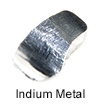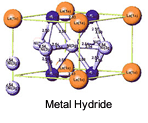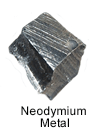THE 2011 U.S. ENDANGERED ELEMENTS LIST™ (EEL11)
A 2011 List of the Top 5 Most Threatened Metals on the Periodic Table that Endanger the Long Term Prospects for America
Prepared by
Alisha A. Ahern, Co-Director
Academics & Periodicals Department, American Elements
INTRODUCTION
America is about to face a crisis that will determine whether it will hold its place as the largest economy and most powerful nation in the world. While the U.S. has been focused for the past 10 years on issues in its financial sector and a war on terrorism a greater danger has been brewing that most Americans seem completely unaware of. America no longer has the resources to manufacture the things we invent. This fact will have a long term impact on the country that is far greater than either the banking collapse or Islamic extremism because it goes to our fundamental ability to generate prosperity, create jobs, defend ourselves militarily and compete in the global economy. American Elements created this first 2011 U.S. Endanger Elements List (EEL11) to bring attention to this serious crisis in hopes that Americans and their elected officials will address it before it is too late.
ABOUT THE LIST
Today it is a constant refrain that the way out of our present fiscal difficulties is for America to get back in the business of making things. Manufacturing generates the needed jobs and resulting prosperity that have pulled us out of each recession for the last 150 years. American innovation, particularly in the area of green technology, it is said will foster whole new industries, jobs and economic growth at the beginning of the 21st Century similar to the impact made at the beginning of the 20th Century by the inventions of Alexander Graham Bell (telephones), Thomas Edison (electricity) and Henry Ford (cars).
While much of this is true, innovation is in fact only the starting point. To manufacture the products flowing from great ideas, a nation must also have access to the critical materials on which the discoveries are based. Each of the metals on the periodic table has its own somewhat alchemistic properties. These properties underlie every great invention. Bell and Edison were successful because they could rely on the copper mines of the southwest for the massive amount of electrically conductive copper needed to build the telephone lines and power lines their inventions required. Ford could reach to the iron and coal mines of the Appalachians for the key components of the steel to build his cars and Texas for the oil and gas necessary to fuel and lubricate them.
The coming innovations of the 21st Century will also require massive amounts of various metals. However, the metals of the 21st Century are very different from the ones that mattered in the 20th Century. Copper, iron, nickel and tin have given way to somewhat exotic sounding metals a lot further down the Periodic Table; metals that all Americans need to quickly get familiar with because at present we mine almost NONE of them. Additionally, we have made virtually no effort to deal with this strategic gap in our ability to manufacture the things we invent; either domestically or in our foreign policy towards mineral-rich nations.
The primary purpose of the EEL11 is to bring attention to this crisis and to educate Americans as to (1) which metals are critical, (2) what makes them essential and endangered and (3) what other nations, particularly China, are doing to assure they can produce what they (or we) invent.
THE 2011 ENDANGERED ELEMENTS LIST
#5 TUNGSTEN

 Tungsten has been called the "strongest" metal on the periodic table. It has the highest melting point and greatest tensile strength of any element. Its hardness is greater than most grades of steel. Thomas Edison relied on these properties to create the light bulb. Tungsten is used anywhere that high temperatures and/or hardness and strength are
Tungsten has been called the "strongest" metal on the periodic table. It has the highest melting point and greatest tensile strength of any element. Its hardness is greater than most grades of steel. Thomas Edison relied on these properties to create the light bulb. Tungsten is used anywhere that high temperatures and/or hardness and strength are
essential. This includes countless aerospace, electronics and defense applications. In spite of tungsten’s critical strategic importance to both industry and our military (from bullets to armor), the United States discontinued ALL tungsten production in the 1990s. Today 85% of global tungsten production occurs within the boundaries of one country-China and China has indicated it may soon discontinue exporting tungsten altogether due to increasing domestic demand.
#4 INDIUM

Indium is a shiny metal that is so soft it can be etched with your fingernail. When compounded to form indium tin oxide (ITO) it is essential to the production of flat panel devises such as televisions and computer screens. Synthesized as copper indium gallium selenide (CIGS) it is fundamental to state of the art solar energy panels. In its pure form it is also critical to modern electronics. Even given its many critical applications, like  tungsten, America currently mines NO indium. More than ½ of world production is again concentrated in China. Possibly most worrying are current estimates that the entire world may run out of indium within the next 20 years.
tungsten, America currently mines NO indium. More than ½ of world production is again concentrated in China. Possibly most worrying are current estimates that the entire world may run out of indium within the next 20 years.
#3 TELLURIUM

Tellurium is technically not a metal. It is classified with a group of strange elements called the "Metalloids". Today it is primarily used in steel alloys to  make them more machinable. However, it is increasingly becoming an essential layer in solar panels in the form of cadmium telluride. The world’s largest solar panel manufacturer, First Solar, smartly acquired a Mexican tellurium mine this year to assure it has a long term continued supply. But many question whether global demand will outstrip supply. Annual global production is approximately 200 tons, yet demand is projected to reach 800 tons by 2013.
make them more machinable. However, it is increasingly becoming an essential layer in solar panels in the form of cadmium telluride. The world’s largest solar panel manufacturer, First Solar, smartly acquired a Mexican tellurium mine this year to assure it has a long term continued supply. But many question whether global demand will outstrip supply. Annual global production is approximately 200 tons, yet demand is projected to reach 800 tons by 2013.
#2 LANTHANUM

Lanthanum has dozens of applications, but the most critical is as the essential ingredient for electric car metal hydride batteries. Each Toyota Prius™ contains 15 lbs. of lanthanum. Access to lanthanum will determine which nations will build the millions of future electric cars. Lanthanum is the first of a group of 17 metals at the very bottom of the periodic table known collectively as the lanthanide series or " rare earths". Each of the rare earth metals has its own unique set of properties that are critical to some future trillion dollar industry. As a group, their availability will determine which countries will dominate high technology manufacturing in the 21st Century. #1 on this year’s EEL is also one of the rare earths. Today China mines 97% of all global rare earth production. America presently produces NONE. The only rare earth mine in the U.S., the  Molycorp mine in Mountain Pass, California was closed in the 1990s, but is scheduled to re-open next year. However, Molycorp will not come close to meeting U.S. rare earth demand. Other U.S. rare earth mines, such as the Ucore mine at Bokan Mountain, Alaska are years from approval unless the federal government and environmentalists can find a way to expedite the approval process.
Molycorp mine in Mountain Pass, California was closed in the 1990s, but is scheduled to re-open next year. However, Molycorp will not come close to meeting U.S. rare earth demand. Other U.S. rare earth mines, such as the Ucore mine at Bokan Mountain, Alaska are years from approval unless the federal government and environmentalists can find a way to expedite the approval process.
#1 NEODYMIUM

Named by our team of experts as "The most essential metal of the 21st Century", the numerous game changing technologies that rely on neodymium combined with its near complete control by China makes it the #1 U.S. Endangered Element of 2011. Neodymium has two wholly unrelated characteristics, either of which would put it on this year’s list. First, when alloyed with Iron and Boron, it forms the world’s strongest magnet. As a result, today’s electric motors are significantly more powerful. Cars are already loaded with these electric motors and future electric cars will require a lot more neodymium. This same characteristic also makes it an essential material for wind power. Wind energy generators are just electric motors in reverse. Electric motors turn electrical energy into mechanical energy (wheels turning). Wind turbines convert mechanical energy (turning of blades by wind) into electrical energy. As such, neodymium is also an essential material for all wind energy technology. And its great magnetic power has many other applications, such as in all IPod™ headphones and in Magnetic Resonance Imaging (MRI) medical equipment to name a few. The second game changing characteristic of neodymium is exhibited when it is used in glass or crystal. Neodymium glass has the almost magical ability to absorb and emit certain colors of the visible spectrum. This light  absorbing/emitting capability has lead to many new technologies. Laser eye surgery is performed using a neodymium crystal laser. When light passes through neodymium glass, it absorbs the portion of the light in the yellow wavelength. GE’s Reveal™ Light Bulb produces a whiter light using neodymium. All modern welding goggles and camera lenses use neodymium to remove the eye damaging yellow wave length. As one of the "rare earth" elements (rare earths are discussed above under lanthanum), China presently has a complete monopoly on neodymium production. The cost of the metal has soared from $10/lb. two years ago to over $400/lb. today. China has indicated it may soon stop exporting neodymium and every new planned rare earth mine outside of China combined will not come close to meeting world demand which is expected to increase dramatically.
absorbing/emitting capability has lead to many new technologies. Laser eye surgery is performed using a neodymium crystal laser. When light passes through neodymium glass, it absorbs the portion of the light in the yellow wavelength. GE’s Reveal™ Light Bulb produces a whiter light using neodymium. All modern welding goggles and camera lenses use neodymium to remove the eye damaging yellow wave length. As one of the "rare earth" elements (rare earths are discussed above under lanthanum), China presently has a complete monopoly on neodymium production. The cost of the metal has soared from $10/lb. two years ago to over $400/lb. today. China has indicated it may soon stop exporting neodymium and every new planned rare earth mine outside of China combined will not come close to meeting world demand which is expected to increase dramatically.
Alisha A. Ahern is the co-director of the Academics & Periodicals Department at American Elements which promotes an understanding of advanced materials and materials science. The department sponsors over 100 technology conferences globally each year, supports materials science education at the high school, college and graduate school levels and earlier this year co-sponsored a 4 part PBS NOVA series titled "Making Stuff" on the impact materials will have on future technology.